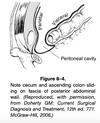Inguinal Hernia Flashcards
(168 cards)
A 25/M undergoes emergency surgery for an incarcerated inguinal hernia. Following induction of anesthesia and just as soon as the inguinal incision is made, the incarcerated organ slips back into the abdominal cavity. In this patient:
A. The inguinal incision should be closed and a laparotomy performed.
B. The inguinal surgery should proceed and an attempt at retrieving the incarcerated organ made by cutting through the internal ring.
C. The hernia repair should proceed and when completed, a laparotomy performed.
D. If the fluid in the sac is clear and straw-colored, assume that the incarcerated organ is viable and only the groin surgery is necessary.
D.
If the fluid in the sac is clear and straw-colored, assume that the incarcerated organ is viable and only the groin surgery is necessary
A 15-year old female presents with a 2 year history of a non-reducible R inguinal mass. The mass is found to be firm, movable, non-reducible with no skin discoloration on physical examination. Abdominal findings were normal but the patient has fever and weight loss. What would be your most likely consideration?
A. Non-specific lymphadenitis
B. Incarcerated indirect inguinal hernia
C. Strangulated indirect inguinal hernia
D. Lymphoma
D. Lymphoma
A 30/M has a reducible inguinal mass. Three hours prior to consult, the mass became non-reducible with the patient complaining of severe pain. Abdominal findings were normal. The mass is located at the R inguinal region and is noted to be tender, fixed with no skin discoloration. What is the initial approach for this patient?
A. Perform emergency herniorrhaphy
B. Start IV resuscitation
C. Do a midline laparotomy incision
D. Do taxis
B. Start IV resuscitation
A patient previoiusly diagnosed to have a right indirect inguinal hernia noticed that the mass has become non-reducible for a day. On PE, he has a T of 38.9 C, the mass is noted to be tender and warm. He has direct and rebound tenderness at the right lower quadrant of the abdomen. What would be your surgical approach?
A. Laparotomy
B. Inguinal herniorrhaphy
C. Laparoscopic surgery
D. Mesh herniorrhaphy
A. Laparotomy
During a laparoscopic examination of the deep surface of the lower anterior abdominal wall, an incidental finding was a herniation of omentum below the inguinal ligament and medial to the external iliac vein. You now diagnose the patient as having
A. An indirect inguinal hernia
B. A direct inguinal hernia
C. A femoral hernia
D. An obturator hernia
C. A femoral hernia
Type of hernia with an indirect and direct hernia component?
Pantaloon hernia
Most common hernia:
Indirect inguinal hernia
What is your differential diagnosis for a groin mass?
Abscess
Epidermal inclusion cyst
Femoral artery aneurysm
Hernia
Hydrocele
Hematoma
Seroma
Lymphadenopathy
Sarcoma
Testicular torsion, and
Undescended testicle
On what side do inguinal hernias usually occur?
Right side
(delay in atrophy of processus vaginalis, after slower descent of right testis to scrotum during fetal development)
On what side do femoral hernias usually occur?
Right side
(possibly from tamponading effect of sigmoid colon on left femoral canal)
What type of hernia are most strangulated hernias?
Indirect inguinal hernia
What ligament is formed by the periosteum and fascia along the superior pubic ramus?
Cooper ligament

What attaches the testicle to the scrotum?
The gubernaculum

Name the contents of the spermatic cord:
Cremasteric muscle fibers
Testicular artery
Testicular pampiniform venous plexus
Genital branch of the genitofemoral nerve
Vas deferens, and
Processus vaginalis ± hernia sac

What are the boundaries of the inguinal canal?
Anterior: External oblique aponeurosis
Posterior: Transversalis fascia and the aponeurosis of transversus abdominis
Superior: Internal oblique and transversus abdominis musculoaponeurosis
Inferior: Inguinal ligament and lacunar ligament

Where do direct inguinal hernias occur with regard to Hesselbach’s triangle?
Direct hernias occur within Hesselbach’s triangle.

Where do indirect inguinal hernias occur with regard to Hesselbach’s triangle?
Indirect inguinal hernias occur lateral to Hesselbach’s triangle.

What nerve runs anterior to the spermatic cord in the inguinal canal and branches at the superficial inguinal ring?
llioinguinal nerve

What nerve innervates the skin on the lateral side of the scrotum and labia and the cremaster muscle?
The genital branch of the genitofemoral nerve

Which nerves provide sensation to the base of the penis, skin of the groin, and ipsilateral upper medial thigh?
The iliohypogastric and ilioinguinal nerves

What are the boundaries of the femoral canal?
Superior: Iliopubic tract
Inferior: Cooper ligament
Lateral: Femoral vein
Medial: Junction of iliopubic tract and Cooper ligament (lacunar ligament)

What kind of femoral hernias need to be repaired?
All femoral hernias need to be repaired (high incidence of strangulation).
What are the various methods through which a femoral hernia can be repaired?
Cooper ligament repair
(via a preperitoneal approach, or via a laparoscopic approach)

What are the essential steps of femoral hernia repair?
1) Dissection and reduction of the hernia sac.
2) Obliteration of the femoral canal defect in the femoral canal, by approximation of the iliopubic tract to the Cooper ligament versus placement of a prosthetic mesh.















